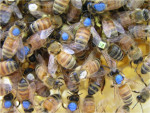Selection of Varroa-tolerant honey bees using drone-breeding worker bees
| Funding code: | NH1-2 |
| Acronym: | |
| Involved employees: | Prof. Dr. K. Bienefeld, F. Zautke |
| Co-operation partners: | |
| Duration: | 1997 - |
| Financing: | Brandenburg, Berlin, Saxony, Saxony-Anhalt, Thuringia |
The ectoparasitic mite Varroa destructor is threatening apiculture worldwide. Breeding Varroa-tolerant bees is one of the main objectives of bee research. Special attention is paid to a selection for increased removal of Varroa-infected pupae from their capped brood cells. This is what studies in recent years have focused on at LIB. During preliminary tests, it could be demonstrated for the first time that the local breed of bees gain a number of effective defensive behavioural patterns (emptying Varroa-infested brood cells) through the application of infrared video technology. The worker bees, who in the course of video observations were shown to be very effective, became drone-breeding with a method developed at LIB last year. Semen produced by maturing drones is used to inseminate queens. A far better genetic progress can be expected compared with other selection methods. The improved Varroa tolerance of this selection lineage is also tested in practice by means of performance tests. Animals of the selection lineage and animals crossbred with other lineages are used in molecular genetic projects to find the genes responsible for Varroa resistance.
Publications:
- Thakur, R.K.; Bienefeld, K.; Keller, R. (1997) Varroa defense behavior in Apis mellifera carnica American Bee Journal 137(2), 143-148
- Thakur, R.K.; Bienefeld, K.; Keller, R. Zautke, F. (1998) Studies on age dependence of defence behaviour against Varroa jacobsoni in the honey bee (Apis mellifera carnica). Apidologie 29(5), 431-433.
- Bienefeld, K.; Thakur, R.K.; Keller, R. (1999) Drohnenbrütige Arbeiterinnen gegen Varroa: Untersuchungen zur Vererbung des Öffnens und Ausräumens varroaparasitierter Brut durch die Honigbiene (Apis mellifera carnica). Deutsches Bienen Journal 7(2), 48-50.
- Bienefeld, K.; Reinsch, N.; Thakur, R.K. (2001) Selection for Uncapping of Varroa infested brood cells in the honeybee (Apis mellifera). Proc. 37. Intern. Apimondia Congress, Durban (Südafrika), Apimondia Publishing House, Bukarest, p 12.
- Knauer, U., Himmelbach, M.; Winkler, F.; Zautke, F.; Bienefeld, K., Meffert, B. Application of an Adaptive Background Model for Monitoring Honeybees, Reviewed Proc. 5th IASTED International Conference on Visualization, Imaging, & Image Processing, Benidorm, Spain, 2005, p. 46-50
- Knauer, U. Zautke, F. Bienefeld, K.,Meffert, B. (2007) A Comparison of Classifiers for Prescreening of Honeybee Brood Cells, Proc. of ICVS2007 International Conference on Computer and Vision System , , p 1-11,
- Knauer, U.; Bienefeld, K., Meffert, B. (2007) Potential of digital image processing for the observation of honeybee behaviour. Apidologie 38(5), 491
- Bienefeld, K. (2009) The use of drone layers for breeding Varroa-resistant honeybees. Proc. 9th International Conference of the Societas Internationalis pro Conservatione Apis mellifera mellifera (SICAMM) with Bee Improvement and Bee Breeders' Association (BIBBA) and Scottish Beekeepers Association (SBA), Avimore, p 5.


